THE FITNESS COMMUNITY, RESEARCHERS, AND ELITE ATHLETES: EVERYONE WANTS BLOOD FLOW RESTRICTION TRAINING
An introductory blog post on blood flow restriction training
By Andreas Kjærsgaard Christensen, MSc Sport Science, Head of Education in Occlude
Blood flow restriction (BFR) training is one of the new buzzwords in exercise science, rehabilitation, and performance optimization. In recent years, BFR training has gained wide interest and popularity in the fitness community, among elite athletes, in professional rehabilitation and healthcare, and in research groups, all over the world. Hence, I’ve chosen the fitting headline for this blog post: “Everyone Wants Blood Flow Restriction Training.” But what is BFR training, and how does it work? How is it practiced, and who is it relevant for? I will try to answer these and other questions in this introductory evidence-based post about BFR training. This post provides the essential basic knowledge required for safe and effective BFR training. I recommend that everyone reads this before starting to use BFR.
In Occludes Knowledge Lab, we write about specific topics and patient groups relevant to BFR training (rehabilitation, sports performance, ACL-rehab, hemodynamics etc.,). You can find all our blog posts here.
Level of evidence
BFR training continues to attract interest and attention in scientific communities, with the number of publications growing each year, especially within the last 10 years. Several well-known international researchers and their groups in fields like strength training, aerobic training, muscle & exercise physiology, and rehabilitation are engaged in BFR training. As of November 2023, no fewer than 1200 papers on “blood flow restriction training”, “occlusion training”, and “kaatsu training” have been published.
The brief history about blood flow restriction training
Scientific and practical interest in BFR training has gained significant momentum from around 2010 onwards. However, the foundation for BFR training as we know it today was built many years ago. Back in the 1960s, Japanese researcher Dr. Youshiaki Sato experimented with training under the restriction of blood flow, which later developed into “kaatsu training” meaning “training with added pressure”. Today, the commonly used terms for blood flow restriction training are either “blood flow restriction training” or “blood flow restriction exercise,” popularly abbreviated as BFR training or BFR exercise [1]. In research, “vascular occlusion training”, “arterial occlusion training”, and “occlusion training” are also terms referring to blood flow restriction training.
What is BFR training?
BFR training can be understood as physiological shortcut to increase muscle size (hypertrophy), strength, and improve physical function, with minimal load on joints, ligaments, and tendons. During BFR training, a cuff is applied to the most proximal part of an extremity, either the arms or legs. The cuff is then inflated to a specific pressure (in mmHg), determined by the individual’s complete arterial occlusion pressure (AOP). The correct pressure in the cuff will partially restrict arterial inflow (oxygenated blood flowing to the muscle) and fully occlude venous return (deoxygenated blood flowing away from the muscle) [1, 2].
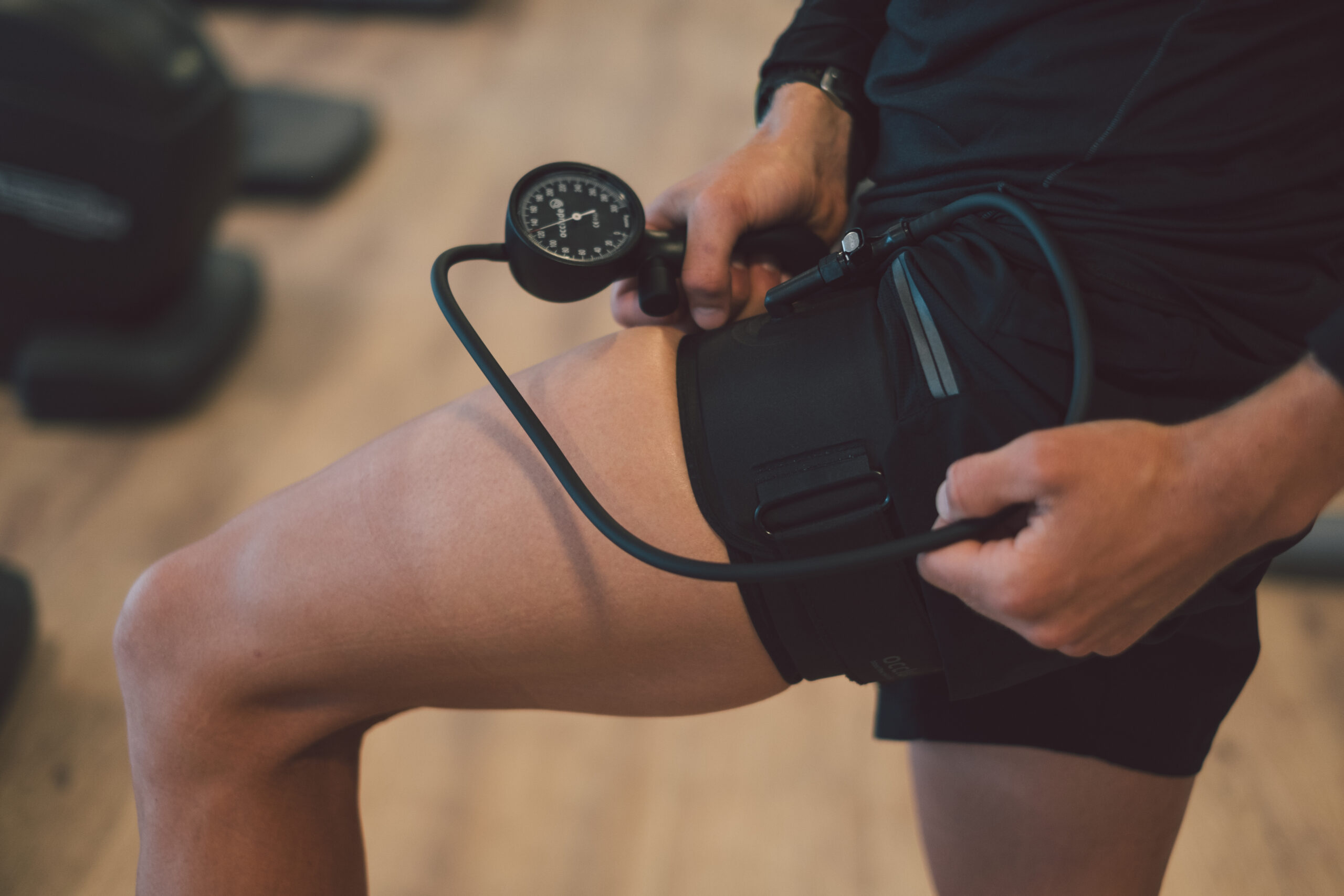
Pneumatic blood flow restriction training equipment
Complete arterial occlusion pressure (AOP) is the pressure where arterial inflow is completely restricted/occluded, also referred to as 100% AOP. Blood flow restriction training is typically practiced at pressures between 40 and 80% of AOP.
What loads and protocols
In contrast to conventional free-flow strength training, BFR training involves exercise and training with low loads. Typically, the load in BFR ranges between 20 % and 40 % of one-repetition maximum (1 RM), but the load can be as “low” as applied passively. This is also known as passive BFR. An exercise typically consists of 2-4 working sets, with a 30-60 second rest between each set. Most protocols maintain the restriction of blood flow during set-rest (continuous BFR), but BFR can also be applied intermittently (intermittent BFR). The latter than be useful when introducing BFR to new users, who need to become accustomed to the training form.
Two commonly used training protocols are either the “30-15-15-15” repetitions protocol or 2-4 sets to concentric failure, both separated by 30-60 seconds rest between sets. With an execution speed of 1-2 sec per rep. the total restriction time ranges from 5-10 minutes per exercise. Between two BFR exercises that are not performed as a superset, the pressure is released, or the cuffs are completely removed, allowing for blood reperfusion [1].
Restriction time and exercises
BFR training sessions with a total restriction time exceeding 17 minutes have been performed [3], but we generally recommend a maximal restriction time of 10 minutes, before the release of pressure. If multiple exercises with BFR are to be performed, take 3-5 min rest without BFR applied and continue your session.
BFR can be performed in both single-joint and multi-joint movements, unilateral or bilateral, and in combination with bodyweight exercises, free weights and machines. BFR is applied exclusively for the lower extremity or upper extremity but never at the same time. BFR can also be combined with continuous aerobic activities such as walking or cycling. This can relevant in rehabilitation, for the frail or elderly, or in the context of recovery.
The load-pressure continuum
BFR training protocols should be designed with an understanding of the load-pressure continuum, to optimize exercise outcomes. The load-pressure continuum describes the inverse relationship between the load (% of 1RM) and the pressure (% of AOP) used in BFR training. When BFR is applied passively or with a very-low load (~ 0-20 % of 1 RM) increasing the pressure up to 80 % of AOP will accelerate the muscular fatigue. A high level of muscle fatigue is essential for a robust training response to occur.
Inversely, as training intensity increases to the highest BFR training intensities (20-40 % of 1RM) lower pressures (40-60 % of AOP) are adequate to cause sufficient accelerated muscle fatigue, hence, a training response.
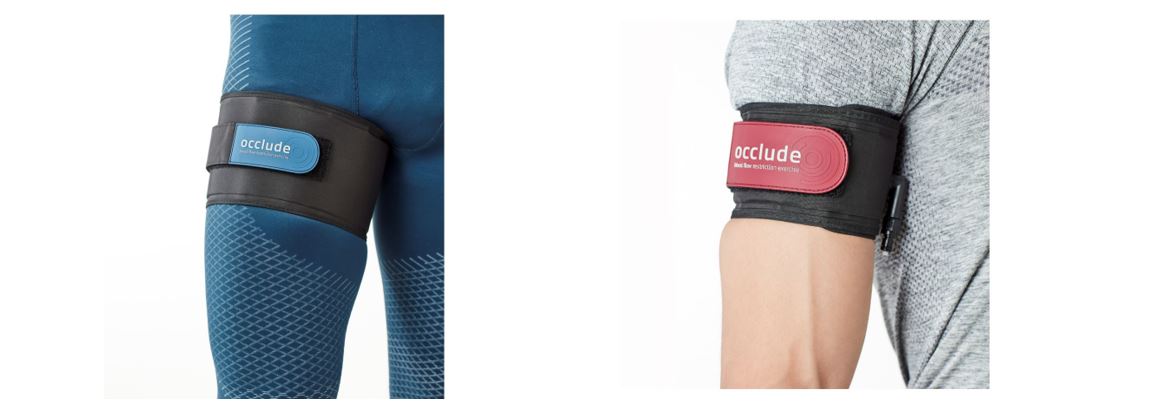
A proximal placement of the blood flow restriction cuff around a limb
- The leg cuff is placed most proximal on the thigh, right below the gluteal muscle.
- The arm cuff is placed most proximal on the upper arm, right below the shoulder, often covering the bottom part of the lateral deltoid muscle.
Who is Blood Flow Restriction Training Relevant For?
The combination of low load and high muscle fatigue makes blood flow restriction training particularly relevant in rehabilitation (after injury or surgery) or for subgroups that cannot tolerate training under high mechanical load. Examples include:
- Rehabilitation after orthopedic surgery: ACL and other ligament injuries requiring reconstruction, after surgery for meniscus tear or muscle/tendon reinsertion and after joint reconstruction/replacement (e.g. TKA/THA)
- Rehabilitation after injuries requiring tissue unloading/immobilization, such as fractures, tendon and muscle ruptures, and overuse injuries.
- Training with patients and clients who cannot tolerate high mechanical load, such as those with osteoarthritis, subgroups of the elderly or frail, and individuals experiencing pain with traditional and more high-intense training.
Injury-free athletes and strength training enthusiasts can also benefit from BFR training as a supplement to or a de-load from their heavy strength training. Research has successfully shown BFR training to be an effective supplement to heavy strength training for American college football players [4, 5].
The characteristic blood pooling with BFR training: Red/purple colour and swelling of the limb
For more videos please visit our Youtube page or Instagram
The effects of BFR training on muscle hypertrophy and strength
The ability of BFR training to induce changes in both muscle mass and strength is well-documented. BFR training is a very potent stimulus to increase muscle mass, comparable to the changes seen after heavy strength training. In a meta-analysis from 2018, an average increase in muscle mass of about 7% after 21 training sessions was observed, for both heavy strength training (> 65% of 1 RM) and low-load BFR strength training (< 50% of 1 RM) [6]. Comparable results have also been observed for strength training in general [7] as long as strength training is taken to a high level of muscular failure.
BFR training also improves maximum strength [8, 9], although not to the same extent as heavy strength training [6]. The 2018 meta-analysis from Lixandrao also investigated the difference in strength adaptations between low-load BFR training and heavy strength training. The results showed that the average strength gain for both training modalities was 14.36% over 21 training sessions but there was a statistically significant difference of 7.36% in favor of heavy strength training [6].
This corresponds to an improvement in maximum strength of about 11% for those who trained BFR with low-load and about 18% for those who trained with heavy load. The difference in strength gain between the two modalities is primarily explained by neural adaptations.
A supplement to heavy strengh training
The combination of heavy strength training and BFR training is likely the strongest stimulus when the goal is to improve both maximum strength and increase muscle mass. Two studies have examined the effect of BFR training as a supplement to heavy training in American College football players. The participants first performed their heavy strength training and finished the workout with BFR training with 30-20-20-20 repetitions in squat and bench press, respectively. The combination significantly improved strength and hypertrophy more than heavy strength training alone [4, 5].
In this context, athletes in sports like handball, basketball, rugby, football, and ice hockey-where a high level of strength and mass correlates with better sports performance- can benefit from the combination of BFR training and heavy strength training. Conversely, athletes highly dependent on strength-mass ratio (such as sprinters, jumpers, gymnasts, etc.) should approach BFR more cautiously in non-rehab settings.
Thus, BFR training is an effective tool for increasing both muscle mass and strength, especially in populations or clinical contexts, where heavy strength training cannot be performed. Based on the available evidence, BFR training should not replace heavy strength training for the healthy and pain-free, as it is inferior to increase strength and neural adaptation to high-intensity strength training modalities.

Professional handball player 80 year old osteoarthritis patient using blood flow restriction in her training
Safety and Contraindications
Blood Flow Restriction (BFR) training is generally considered a safe form of exercise [1, 10, 11], with a very low incidence of any serious side effects [12]. To minimize the risk of adverse events, it is recommended to screen patients for contraindications related to BFR training, individualize the pressure to 40-80% of arterial occlusion pressure (AOP), possess knowledge of cuff placement and the impact of cuff width, and avoid prolonged restriction time [11].
To reduce initial muscle soreness and damage, and to take advantage of the repeated bout effect, it is recommended to do a run-in phase where patients and clients will receive a gradual exposure to BFR training [13].
In Occlude’s workshops and courses, we recommend the following run-in protocol for new users of BFR training. In addition to the reduction in delayed onset of muscle soreness (DOMS) patients can experience, we do this because research has shown a significant adaptation in self-reported exertion and pain during training over the first six BFR training sessions [14], which is important to consider to optimize training/rehab compliance.
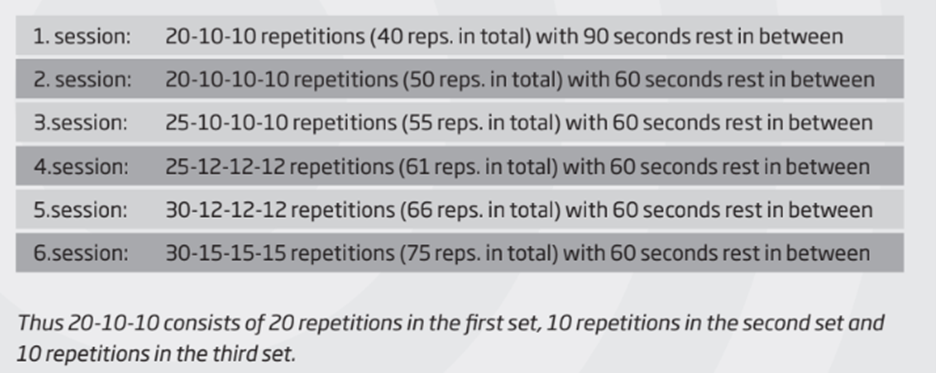
Suggested run-in protocol for new users of blood flow restriction training
Despite research showing improvements in various health aspects, such as:
- Vascular function in older individuals through improved flow-mediated vasodilation (FMD), cardio ankle vascular index (CAVI) and ankle brachial index (ABI) after long-term BFR training [15]
- Hemodynamics in older patients [16]
- Function, strength, quality of life and also is well tolerated in patients with heart failure [17]
- Strength and is considered feasible in patients following cardiovascular surgery [18]
more studies are needed to fully understand the potential of blood flow restriction training in non-healthy populations. As a precaution, the following conditions are considered contraindications:
- Untreated hypertension
- Deep vein thrombosis and pulmonary embolism
- Heart failure
- Stroke
- Cardiovascular diseases
- Excessive post-op swelling
Pneumatic equipment and individual training pressure
Using pressure-regulated and pump-controlled equipment is generally recommended as it allows for the determination of individual blood flow restriction training pressure [1, 10, 11]. The individualized BFR training pressure is determined based on the individual’s arterial occlusion pressure (AOP) and can be recorded in the patient’s or athlete’s medical record for standardized pressure and future use.
Determining individual BFR training pressure can be done using either a Doppler ultrasound (considered gold standard) or a handheld doppler in both the upper- and lower extremities [19]. The validated use of a handheld doppler is convenient for the practitioner in the field.
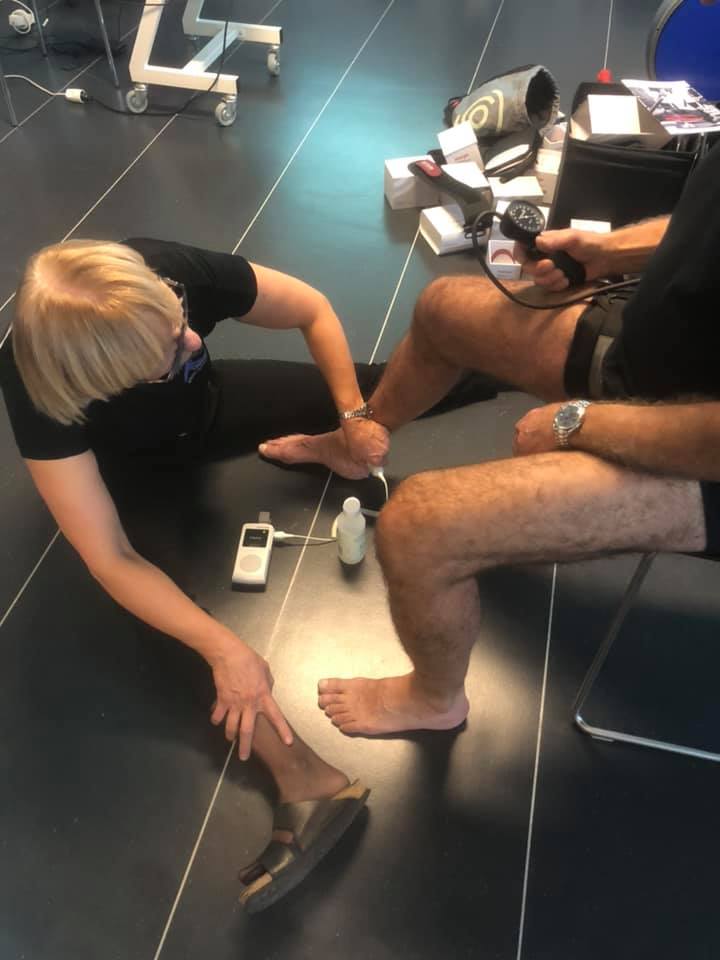
Determination of individual BFR training pressure for the right lower limbs with a handheld doppler at artery tibialis posterior: Pressure is gradually inflated until signal from the artery pulsation is lost. When pulsation is lost, pressure is recorded and set to be 100 % of the indvidual’s arterial occlusion pressure (AOP).
Some individuals choose practical BFR training equipment, such as straps, rigid and elastic bands, where the degree of restriction is subjectively assessed on a perceived tightness scale from 1-10. However, this method has been scientifically tested and has proven to be unreliable [20].
Consideration should also be given to the width of the cuff used in BFR training. The amount of pressure required to restrict blood flow to a limb, is largely determined by the width of the cuff applied to the limb [1].
Narrower cuffs require more pressure to achieve adequate blood flow restriction for a physiological response to occur. As pressures increase, the risk of numbness (nerve compression) also increases [11].
For our leg cuffs, we have chosen a medium width, and for our arm cuffs, a small width. The difference in width between our arm and leg cuffs is based on the typically observed variation in arm and leg circumference within the general population. See the table below for Occlude’s cuff specifications:
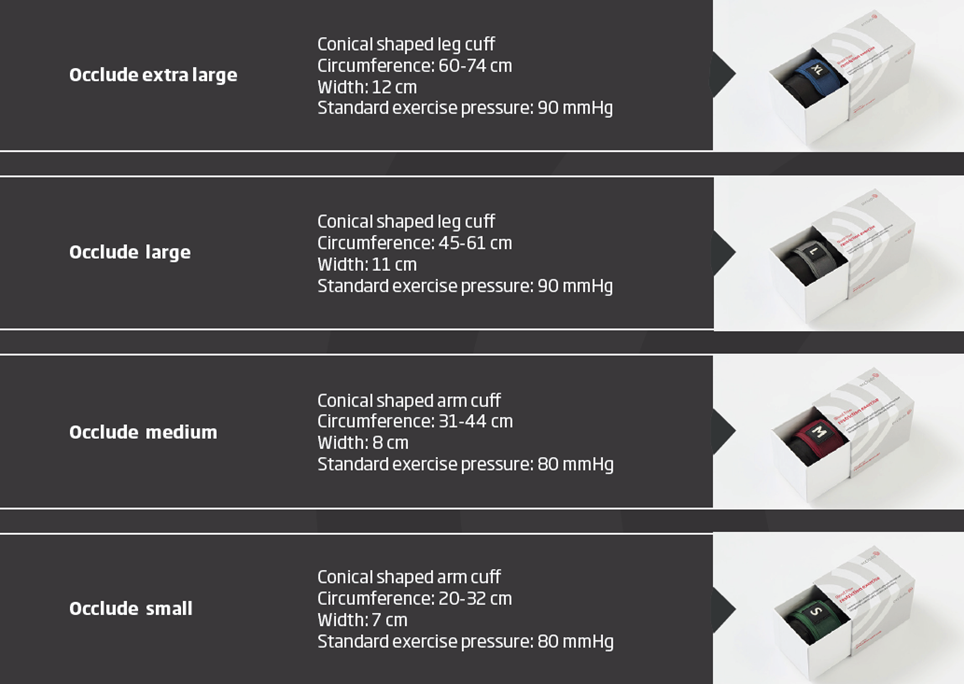
Specifications of Occlude’s blood flow restriction training equipment
Summary
Blood flow restriction (BFR) training has established itself as a valuable tool and a potent training stimulus, particularly in rehabilitation following injury or surgery and for individuals unable to train with or tolerate high mechanical loads. Screening for contraindications is crucial before initiating BFR training, with training pressure set relative to the individual’s arterial occlusion pressure (AOP). Prioritizing heavy strength training or high-intensity training when it can be done without contraindications or pain is recommended. In such cases, BFR training can complement your high intensity training regimen, contributing to increased muscle mass and strength.
References
- Patterson, S.D., et al., Blood Flow Restriction Exercise Position Stand: Considerations of Methodology, Application, and Safety. Front Physiol, 2019. 10: p. 533.
- Scott, B.R., et al., Exercise with blood flow restriction: an updated evidence-based approach for enhanced muscular development. Sports Med, 2015. 45(3): p. 313-25.
- Abe, T., C.F. Kearns, and Y. Sato, Muscle size and strength are increased following walk training with restricted venous blood flow from the leg muscle, Kaatsu-walk training. J Appl Physiol (1985), 2006. 100(5): p. 1460-6.
- Yamanaka, T., R.S. Farley, and J.L. Caputo, Occlusion Training Increases Muscular Strength in Division IA Football Players. The Journal of Strength & Conditioning Research, 2012. 26(9): p. 2523-2529.
- Luebbers, P.E., et al., The effects of a 7-week practical blood flow restriction program on well-trained collegiate athletes. J Strength Cond Res, 2014. 28(8): p. 2270-80.
- Lixandrao, M.E., et al., Magnitude of Muscle Strength and Mass Adaptations Between High-Load Resistance Training Versus Low-Load Resistance Training Associated with Blood-Flow Restriction: A Systematic Review and Meta-Analysis. Sports Med, 2018. 48(2): p. 361-378.
- Schoenfeld, B.J., et al., Strength and Hypertrophy Adaptations Between Low- vs. High-Load Resistance Training: A Systematic Review and Meta-analysis. J Strength Cond Res, 2017. 31(12): p. 3508-3523.
- Lixandrao, M.E., et al., Effects of exercise intensity and occlusion pressure after 12 weeks of resistance training with blood-flow restriction. Eur J Appl Physiol, 2015. 115(12): p. 2471-80.
- Hill, E.C., et al., Early phase adaptations in muscle strength and hypertrophy as a result of low-intensity blood flow restriction resistance training. Eur J Appl Physiol, 2018. 118(9): p. 1831-1843.
- Vanwye, W.R., A.M. Weatherholt, and A.E. Mikesky, Blood Flow Restriction Training: Implementation into Clinical Practice. Int J Exerc Sci, 2017. 10(5): p. 649-654.
- Patterson, S.D. and C.R. Brandner, The role of blood flow restriction training for applied practitioners: A questionnaire-based survey. J Sports Sci, 2018. 36(2): p. 123-130.
- Nakajima, <Nakajima 2006 – Use and safety of KAATSU training. Results of a national survey.pdf>. 2006.
- Sieljacks, P., et al., Muscle damage and repeated bout effect following blood flow restricted exercise. Eur J Appl Physiol, 2016. 116(3): p. 513-25.
- Martin-Hernandez, J., et al., Adaptation of Perceptual Responses to Low-Load Blood Flow Restriction Training. J Strength Cond Res, 2017. 31(3): p. 765-772.
- Zhang, T., G. Tian, and X. Wang, Effects of Low-Load Blood Flow Restriction Training on Hemodynamic Responses and Vascular Function in Older Adults: A Meta-Analysis. Int J Environ Res Public Health, 2022. 19(11).
- Kambic, T., et al., Blood Flow Restriction Resistance Exercise Improves Muscle Strength and Hemodynamics, but Not Vascular Function in Coronary Artery Disease Patients: A Pilot Randomized Controlled Trial. Front Physiol, 2019. 10: p. 656.
- Groennebaek, T., et al., Effect of Blood Flow Restricted Resistance Exercise and Remote Ischemic Conditioning on Functional Capacity and Myocellular Adaptations in Patients With Heart Failure. Circ Heart Fail, 2019. 12(12): p. e006427.
- Ogawa, H., et al., Low-Intensity Resistance Training with Moderate Blood Flow Restriction Appears Safe and Increases Skeletal Muscle Strength and Size in Cardiovascular Surgery Patients: A Pilot Study. J Clin Med, 2021. 10(3).
- Vehrs, P.R., et al., Use of a handheld Doppler to measure brachial and femoral artery occlusion pressure. Front Physiol, 2023. 14: p. 1239582.
- Bell, Z.W., et al., The Perceived Tightness Scale Does Not Provide Reliable Estimates of Blood Flow Restriction Pressure. J Sport Rehabil, 2019: p. 1-3.